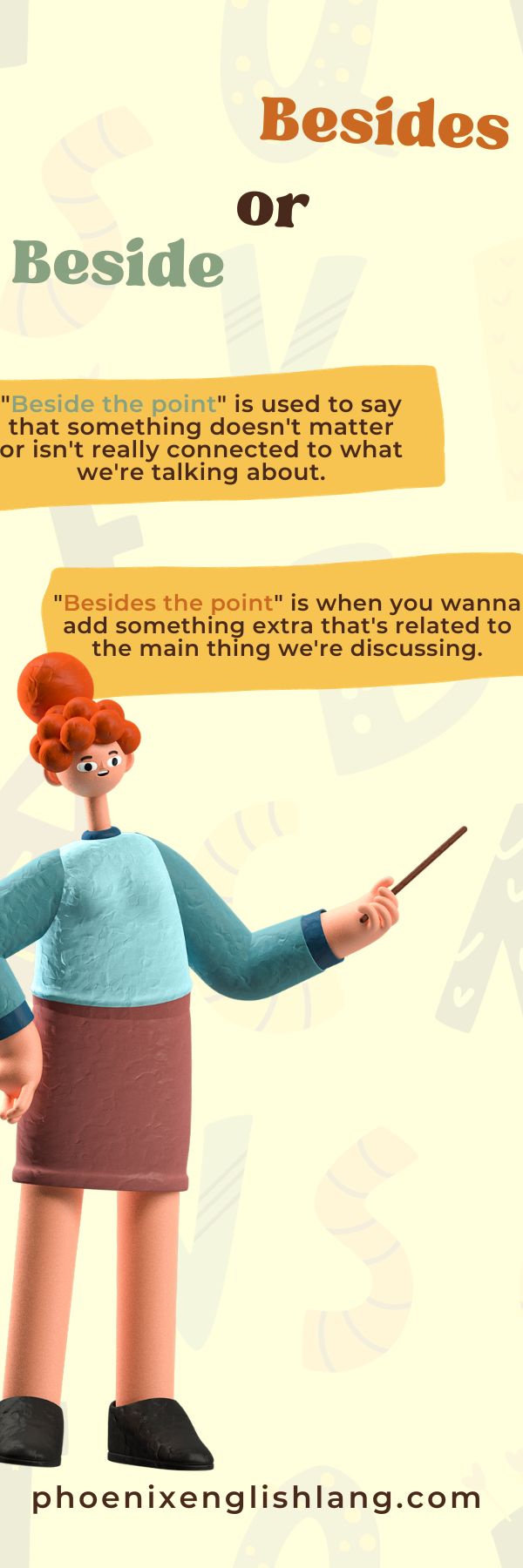The phrases “beside the point” and “besides the point” often cause confusion due to their similar appearance and sound. However, they carry distinct meanings and usages that are important to understand for effective communication. When I delve into these expressions, I find that they both serve to highlight the relevance or irrelevance of information in a conversation or argument, but they do so in subtly different ways.
“Beside the point” is a phrase used to indicate that something is irrelevant or not directly related to the main topic of discussion. For instance, if I am discussing the benefits of a healthy diet and someone mentions the color of the plates, I might say that the color of the plates is beside the point.
This phrase helps to steer the conversation back to the central issue, emphasizing that certain details, while perhaps interesting, do not contribute to the core argument or discussion.
On the other hand, “besides the point” can sometimes be used interchangeably with “beside the point,” but it also has a slightly different nuance. “Besides” can mean “in addition to” or “apart from,” which can add a layer of meaning to the phrase.
For example, if I am arguing that a particular policy is ineffective and someone brings up a minor benefit of the policy, I might say that this benefit is besides the point, implying that it is an additional detail that does not change the overall ineffectiveness of the policy.
This usage can subtly shift the focus to acknowledge the additional detail while still maintaining that it does not alter the main argument.
Understanding these nuances is crucial for clear and precise communication. When I use “beside the point,” I am often trying to dismiss irrelevant information to keep the discussion focused.
When I use “besides the point,” I might be acknowledging an additional detail but still emphasizing its lack of impact on the main issue. This distinction can help in making arguments more coherent and avoiding misunderstandings.
In everyday conversations, these phrases can be powerful tools for managing the flow of dialogue. They allow me to gently redirect discussions and ensure that the main points are not lost in a sea of tangential information.
Whether in casual chats, professional meetings, or academic debates, knowing when and how to use “beside the point” and “besides the point” can enhance my ability to communicate effectively and persuasively.
Which one is correct? Besides The Point or Beside The Point?

When I first encountered the phrases “beside the point” and “besides the point,” I found myself puzzled by their similarities and subtle differences. It seemed like a minor detail, but understanding which one is correct can significantly impact the clarity and precision of my communication.
“Beside the point” is the phrase that is most commonly accepted and used in English. It means that something is irrelevant or not directly related to the main topic of discussion.
For example, if I am discussing the importance of exercise for health and someone starts talking about the color of gym equipment, I might say that the color of the equipment is beside the point.
This phrase helps me steer the conversation back to the central issue, emphasizing that certain details, while perhaps interesting, do not contribute to the core argument or discussion.
On the other hand, “besides the point” can sometimes be heard in casual speech, but it is generally considered incorrect in formal writing and speech.
The word “besides” means “in addition to” or “apart from,” which can add a layer of confusion when used in this context. For instance, if I were to say, “The color of the gym equipment is besides the point,” it might imply that the color is an additional detail that does not change the overall importance of exercise.
However, this usage is less precise and can lead to misunderstandings.
Understanding these nuances is crucial for clear and effective communication. When I use “beside the point,” I am often trying to dismiss irrelevant information to keep the discussion focused.
This phrase is straightforward and widely recognized, making it the preferred choice in most situations. Using “besides the point,” on the other hand, can make my argument seem less coherent and may distract from the main issue.
In everyday conversations, using the correct phrase can be a powerful tool for managing the flow of dialogue. It allows me to gently redirect discussions and ensure that the main points are not lost in a sea of tangential information.
Whether in casual chats, professional meetings, or academic debates, knowing when and how to use “beside the point” can enhance my ability to communicate effectively and persuasively.
Reflecting on my own experiences, I realize that mastering these phrases has helped me navigate discussions with greater clarity and precision. For example, during a team meeting at work, I once had to explain why certain budget details were beside the point when discussing the overall project strategy.
By using the correct phrase, I was able to keep the team focused on the strategic goals rather than getting bogged down in minor financial details
Understanding “Beside the Point”

The phrase “beside the point” is commonly used to indicate that a statement or argument is not relevant to the main topic or issue at hand.
This paragraph will provide a clear definition and explanation of the phrase.
You might also enjoy: How Are You Fairing or Faring? Differences + Examples
Examples of “Beside the Point”

In this section, we’re gonna show you a few examples to explain how the phrase “beside the point” is used in everyday conversations.
These examples will help you get the idea and understand how it’s used in real life.
1. “What is your favorite color?” – My personal preferences are beside the point in the context of our conversation.
2. “What is the meaning of life?” – Discussing philosophical concepts like the meaning of life is subjective and can be considered beside the point in the context of our conversation.
3. “What is the best TV show of all time?” – Determining the best TV show is subjective and beside the point in the context of our conversation.
Exploring “Besides the Point”

Similar to “beside the point,” the phrase “besides the point” is also used to say that something is not relevant or not important.
So in this paragraph, we’ll talk about how these two phrases are similar and different, and how you can use them interchangeably.
Examples of “Besides the Point”

To make sure you really get it, we’ll give you more examples that show how “besides the point” is used.
These examples will show you how people use the phrase in different situations and talks.
1. “I understand your concerns about the budget, but besides the point, we need to focus on the overall strategy for the project.”
2. “The color of the packaging is besides the point; what matters is the quality of the product inside.”
3. “While your personal experience is valuable, it is besides the point in this discussion about the broader implications of climate change.”
4. “The minor grammatical errors in the report are besides the point; what matters is the accuracy and relevance of the information presented.”
You might also enjoy: Have fun or Enjoy: Difference + Examples [2024]
Beside The Point
In the world of communication, the phrase “beside the point” is super important.
It’s a term people use a lot when they wanna say that something being said or argued isn’t really related to what we’re talking about right now.
When we say something is “beside the point,” it means it’s not helping with the main point or goal of the conversation.
To really get what “beside the point” means, you gotta look into where it came from and see how it works in different situations.
This phrase comes from logic and rhetoric, where it’s used to point out statements that don’t really have anything to do with the main argument.
By knowing what’s “beside the point,” you can have better conversations and stay focused on the important stuff.
One important thing to understand about “beside the point” is knowing what information is relevant and what’s not. In any discussion, there are certain goals or objectives that people try to achieve.
When someone says something that doesn’t help with these goals, it’s like going off track. This can make things confusing and make it harder to stay on topic.
Also, figuring out what’s off track requires really paying attention and thinking carefully.
It’s super important to tell the difference between things that are totally irrelevant and things that might seem unrelated but actually have a connection to the main topic.
This thing helps us understand the conversation better and stops us from ignoring useful insights.
Besides being important in thinking logically, the idea of “beside the point” is also a big deal in how we talk to each other.
When we’re talking, we often have different ideas and opinions. Sometimes, someone might say something that seems unrelated to others, but it’s actually really important to their point of view.
In those cases, we need to realize that those statements matter and think about them in the bigger picture of the discussion.
To get what is “beside the point,” we also need to understand the importance of the situation we’re in.
Many times, a statement might seem irrelevant at first, but when you look at it closely, you realize it actually matters in a specific situation.
This shows how important it is to think about the bigger picture and not just brush off statements right away.
Also, the idea of “beside the point” goes beyond just individual conversations and applies to bigger discussions in society too.
In public debates and politics, it’s not unusual for people to bring up arguments or information that distract from the main issues.
Being able to recognize these distractions and bring the conversation back to the main points is crucial for having productive and meaningful discussions.
To sum it up, understanding “beside the point” is really important for being a good communicator and thinker.
It’s about spotting statements or arguments that don’t really matter to the main point of a conversation.
By really listening, thinking about the context, and telling apart useless information from possibly useful ideas, people can have better conversations.
Whether it’s in thinking logically, talking to others, or discussing things in society, being able to figure out what is “beside the point” is a useful skill that helps things make sense and move forward.
Besides The Point
“Besides the Point” is like a phrase people use all the time to talk about something that doesn’t really matter to what we’re talking about.
It’s like when someone goes off on a tangent and starts talking about something completely different.
In this article, we’re gonna look at what it means to go “besides the point” and how it affects different situations.
When you’re talking or arguing with someone, it’s super important to stick to the main point or goal.
But sometimes people end up going off track, whether they mean to or not.
This can happen for a bunch of reasons, like not really getting it, having your own opinions, or just not wanting to deal with the real problem.
During arguments or disagreements, people often go “besides the point”.
Instead of talking about the main issue or giving relevant proof, they might just start insulting each other, using bad logic, or bringing up random stuff.
They do this to distract and control the conversation so it goes their way. But it stops us from having useful discussions and solving the real problem.
Besides arguing, people in professional settings can also go off-topic.
In meetings or brainstorming sessions, participants may bring up ideas or suggestions that are not directly related to the agenda or objective.
Even though these ideas may be good on their own, they can sidetrack the discussion and waste time and resources.
It’s important for individuals to realize when they’re going off-topic and bring the conversation back to the main goal.
Also, going “off track” can happen in academic or research situations.
When writing papers or doing studies, researchers might include information or arguments that aren’t directly related to the main research question.
While it’s important to give background information and context, it’s equally important to make sure that the content stays relevant and contributes to the overall goal.
Adding irrelevant information can confuse readers and weaken the impact of the research.
To avoid going “off track,” it’s crucial to listen carefully and think critically.
By actively listening to others and understanding their perspectives, we can better recognize when the conversation is going off-topic.
Additionally, critical thinking skills help us assess the relevance and validity of the points being made, allowing us to bring the conversation back to the main point.
In conclusion, going “besides the point” means like getting off track or going off topic.
It can mess up good discussions, waste time and resources, and make research less effective.
Whether it’s arguing, work stuff, or school stuff, it’s super important to know when we’re getting off track and get back to the main issue.
By listening carefully and thinking hard, we can make sure our conversations and interactions stay on point and get stuff done.
Choosing Between the Two

“Beside the point” and “besides the point” are like pretty much the same thing, you know? In this paragraph, we’ll talk about any little differences in how they’re used.
We’ll also mention any regional or personal preferences that might make someone choose one phrase over the other.
You might also enjoy: Copys or Copies: Differences + Examples [2024]
Point
Both “beside the point” and “besides the point” are phrases that people often use in English.
But they mean slightly different things and are used in different ways.
When we say “beside the point,” we mean that something is not relevant or doesn’t have anything to do with the current topic.
It’s like saying that the thing being talked about is not important or doesn’t add anything to the main argument or focus of the conversation.
For example, if we’re discussing how exercise is good for our health, and someone starts talking about diet, we might say, “That’s beside the point.
We’re only talking about exercise right now.”
On the flip side, “besides the point” is used to bring up another point that’s related to the main topic but doesn’t directly address it.
It basically means that the mentioned point is worth thinking about, even though it’s not the main focus of the conversation.
For example, if a group is talking about how climate change affects agriculture, and someone mentions the importance of sustainable farming practices, another person might say, “That’s a good point, but it’s not really what we’re talking about right now.”
It’s important to note that “beside the point” is the more common phrase and is considered the standard way to say it.
“Besides the point” is less common but still okay in certain situations.
The choice between the two depends on what you mean and the specific situation you’re in.
To sum it up, “beside the point” means something doesn’t matter or isn’t important to the main thing we’re talking about, while “besides the point” brings up another thing that’s related to the main thing.
Both phrases mean different things and you need to understand the situation to know which one to use.
Importance of Staying on Topic

In this part, we’ll talk about why it’s important to steer the conversation back to the main topic or issue.
We’ll also chat about how using phrases like “that’s not the point” or “who cares” can keep things on track and make sure the discussions are fruitful.
Knowing when to use “beside the point” or “besides the point” can help you get your thoughts across effectively.
Both phrases are correct, but they have different meanings and uses that can affect how clear and precise your message is.
“Beside the point” is often used to show that something is not relevant or directly connected to what we’re talking about.
It means that the mentioned point doesn’t really matter or doesn’t add to the main argument or focus of the conversation.
This phrase is often used to bring the conversation back to the main topic or to ignore a tangent that doesn’t matter.
For example, if a group is talking about the importance of renewable energy sources, and someone starts talking about fashion trends, you could say, “That’s not the point.
We need to focus on finding sustainable solutions for energy production.” On the other hand, “besides the point” is used to add an extra point that is related to the main topic but not directly about it.
It suggests that the mentioned point is worth thinking about, even though it’s not the main focus of the conversation.
This phrase is often used to acknowledge a valid but kinda unrelated point or to give more info.
But it does show the need to have a balanced approach to taking care of your mental health.” The choice between “beside the point” and “besides the point” depends on what you’re trying to say and the specific situation.
“Beside the point” is the more common phrase and is considered the normal way to say it. It’s used to brush off or redirect information that doesn’t matter.
“Besides the point” isn’t used as much but it’s still okay in certain situations.
It’s used to bring up another point that’s related to the main topic.
To figure out which phrase to use, think about what you’re trying to say.
If you want to make it clear that something is not important or doesn’t contribute to the main discussion, then “beside the point” is the right choice.
On the other hand, if you want to acknowledge a valid but off-topic point, then “besides the point” is the way to go.
In short, knowing the difference between “beside the point” and “besides the point” helps you express your thoughts effectively and have meaningful conversations.
“Beside the point” dismisses or redirects irrelevant information, while “besides the point” brings up another related point.
By using these phrases correctly, you can make sure that you’re clear and precise in your communication.
You might also enjoy: Align To or Align With: Which is Correct? [+ Examples]
Conclusion
To wrap up our discussion on “beside the point” and “besides the point,” this last paragraph will sum up the main points we talked about in the article.
It will remind us how important it is to use these phrases to get conversations back on track and keep them relevant.

Hi, welcome to my blog! My name is Omid and I am thrilled to have you here! I am an English language teacher with 12 years of experience and hold multiple international certifications (TESOL, IELTS, TOEFL, PTE, CELTA). Additionally, I hold a PhD in Applied Linguistics with a specialization in Teaching English as a Second Language (TESL), which fuels my passion for teaching English and assisting others in mastering the language. To me, nothing is more rewarding than helping individuals enhance their English language abilities through various methods. So, let’s embark on this journey of learning English together.




